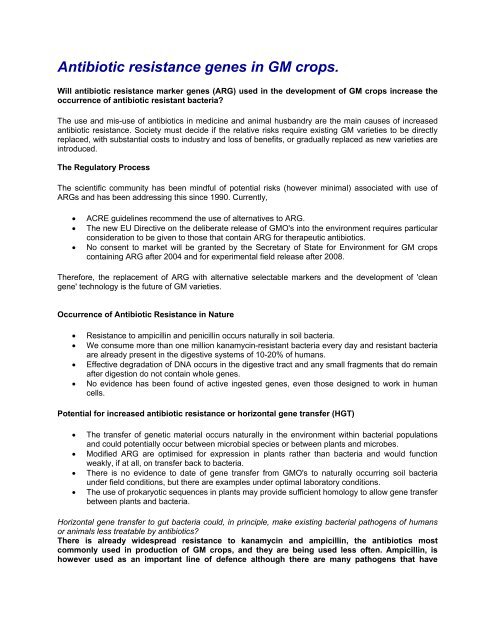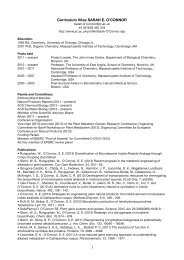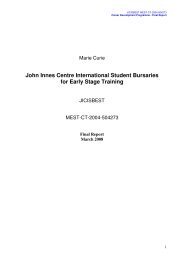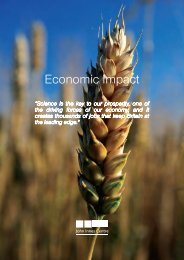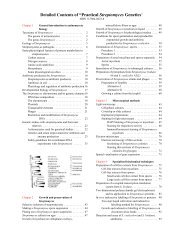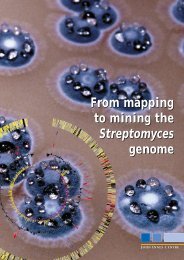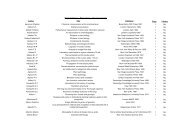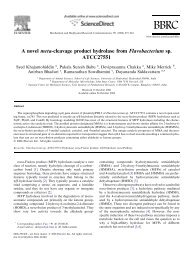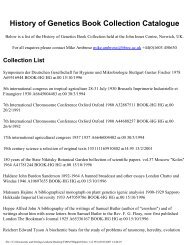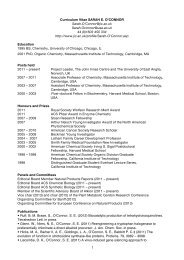Antibiotic resistance genes in GM crops
Antibiotic resistance genes in GM crops
Antibiotic resistance genes in GM crops
Create successful ePaper yourself
Turn your PDF publications into a flip-book with our unique Google optimized e-Paper software.
<strong>Antibiotic</strong> <strong>resistance</strong> <strong>genes</strong> <strong>in</strong> <strong>GM</strong> <strong>crops</strong>.<br />
Will antibiotic <strong>resistance</strong> marker <strong>genes</strong> (ARG) used <strong>in</strong> the development of <strong>GM</strong> <strong>crops</strong> <strong>in</strong>crease the<br />
occurrence of antibiotic resistant bacteria?<br />
The use and mis-use of antibiotics <strong>in</strong> medic<strong>in</strong>e and animal husbandry are the ma<strong>in</strong> causes of <strong>in</strong>creased<br />
antibiotic <strong>resistance</strong>. Society must decide if the relative risks require exist<strong>in</strong>g <strong>GM</strong> varieties to be directly<br />
replaced, with substantial costs to <strong>in</strong>dustry and loss of benefits, or gradually replaced as new varieties are<br />
<strong>in</strong>troduced.<br />
The Regulatory Process<br />
The scientific community has been m<strong>in</strong>dful of potential risks (however m<strong>in</strong>imal) associated with use of<br />
ARGs and has been address<strong>in</strong>g this s<strong>in</strong>ce 1990. Currently,<br />
• ACRE guidel<strong>in</strong>es recommend the use of alternatives to ARG.<br />
• The new EU Directive on the deliberate release of <strong>GM</strong>O's <strong>in</strong>to the environment requires particular<br />
consideration to be given to those that conta<strong>in</strong> ARG for therapeutic antibiotics.<br />
• No consent to market will be granted by the Secretary of State for Environment for <strong>GM</strong> <strong>crops</strong><br />
conta<strong>in</strong><strong>in</strong>g ARG after 2004 and for experimental field release after 2008.<br />
Therefore, the replacement of ARG with alternative selectable markers and the development of 'clean<br />
gene' technology is the future of <strong>GM</strong> varieties.<br />
Occurrence of <strong>Antibiotic</strong> Resistance <strong>in</strong> Nature<br />
• Resistance to ampicill<strong>in</strong> and penicill<strong>in</strong> occurs naturally <strong>in</strong> soil bacteria.<br />
• We consume more than one million kanamyc<strong>in</strong>-resistant bacteria every day and resistant bacteria<br />
are already present <strong>in</strong> the digestive systems of 10-20% of humans.<br />
• Effective degradation of DNA occurs <strong>in</strong> the digestive tract and any small fragments that do rema<strong>in</strong><br />
after digestion do not conta<strong>in</strong> whole <strong>genes</strong>.<br />
• No evidence has been found of active <strong>in</strong>gested <strong>genes</strong>, even those designed to work <strong>in</strong> human<br />
cells.<br />
Potential for <strong>in</strong>creased antibiotic <strong>resistance</strong> or horizontal gene transfer (HGT)<br />
• The transfer of genetic material occurs naturally <strong>in</strong> the environment with<strong>in</strong> bacterial populations<br />
and could potentially occur between microbial species or between plants and microbes.<br />
• Modified ARG are optimised for expression <strong>in</strong> plants rather than bacteria and would function<br />
weakly, if at all, on transfer back to bacteria.<br />
• There is no evidence to date of gene transfer from <strong>GM</strong>O's to naturally occurr<strong>in</strong>g soil bacteria<br />
under field conditions, but there are examples under optimal laboratory conditions.<br />
• The use of prokaryotic sequences <strong>in</strong> plants may provide sufficient homology to allow gene transfer<br />
between plants and bacteria.<br />
Horizontal gene transfer to gut bacteria could, <strong>in</strong> pr<strong>in</strong>ciple, make exist<strong>in</strong>g bacterial pathogens of humans<br />
or animals less treatable by antibiotics?<br />
There is already widespread <strong>resistance</strong> to kanamyc<strong>in</strong> and ampicill<strong>in</strong>, the antibiotics most<br />
commonly used <strong>in</strong> production of <strong>GM</strong> <strong>crops</strong>, and they are be<strong>in</strong>g used less often. Ampicill<strong>in</strong>, is<br />
however used as an important l<strong>in</strong>e of defence although there are many pathogens that have
ecome resistant to it. Its use <strong>in</strong> <strong>GM</strong> plants is very limited and use of kanamyc<strong>in</strong> <strong>resistance</strong> <strong>genes</strong><br />
is be<strong>in</strong>g phased out.<br />
The BBC drama "Fields of Gold" implied the transfer of ARG from <strong>GM</strong> <strong>crops</strong> would create new<br />
pathogens?<br />
Compared to other causes of antibiotic <strong>resistance</strong>, the risk is m<strong>in</strong>imal.<br />
References<br />
1. Levy SB (2000) The <strong>Antibiotic</strong> Paradox: How the misuse of antibiotics destroys their curative<br />
powers Perseus Press<br />
2. Wegener HC, Aarstrup FM, Jensen LB, Hammerum AM, and Bager F. (1999) Use of antimicrobial<br />
growth promoters <strong>in</strong> food animals and Enterococcus faecium <strong>resistance</strong> to therapeutic<br />
antimicrobial drugs <strong>in</strong> Europe. Emerg. Infect.Dis. 5(3), 329 - 335<br />
3. Guidance on Pr<strong>in</strong>ciples of Best Practice <strong>in</strong> the Design of Genetically Modified Plant. (2001)<br />
Advisory Committee on Releases to the Environment: Sub-group on Best Practice <strong>in</strong> <strong>GM</strong> Crop<br />
Design<br />
4. Directive 2001/18/EC of the European Parliament and of the Council on the deliberate release <strong>in</strong>to<br />
the environment of genetically modified organisms and repeal<strong>in</strong>g Council Directive 90/220/EC<br />
5. Beever DE and Kemp CF (2000). Safety issues associated with the DNA <strong>in</strong> animal feed derived<br />
from genetically modified <strong>crops</strong>. A review of scientific and regulatory procedures. Nutri.Abstr. Rev.<br />
Series B: Livestock Feeds and Feed<strong>in</strong>g 70(3), 175-182<br />
6. Bertolla F and Simonet P (1999). Horizontal gene transfer <strong>in</strong> the environment: natural<br />
transformations as a putative process for gene transfer between transgenic plants and microorganisms<br />
7. Forano E and Fl<strong>in</strong>t H.J. (2000) Genetically modified organisms: consequences for rum<strong>in</strong>ant health<br />
and nutrition. Annales de Zootechne 49, 255-271<br />
8. Davison J (1999) Genetic exchange between bacteria <strong>in</strong> the environment. Plasmid 42 73-91.<br />
9. Droge M, Puhler A and Selbitschka W (1998) Horizontal gene transfer as a biosafety issue; a<br />
natural phenomenon of public concern. Journal of Biotechnology 64 75-90<br />
10. Paul JH (1999) Microbiological gene transfer; an ecological perspective. Journal of Molecular<br />
Microbiology and Biotechnology 1 45-50<br />
11. Nielsen KM, van Weerelt MDM, Berg T, Bones AM, Hagler AN and van Elsas JD et al (1997)<br />
Natural transformation and availability of transform<strong>in</strong>g DNA to Ac<strong>in</strong>etobacter calcoaceticus <strong>in</strong> soil<br />
microcosms. Applied and Environmental Microbiology 63 1945-1952.<br />
12. Syvanen M (1999) In search of horizontal gene transfer. Nature Biotechnology 17 833.<br />
13. de Vries J and Wackernegel W (1998) Detection of nptII (kanamyc<strong>in</strong> <strong>resistance</strong>) <strong>genes</strong> <strong>in</strong><br />
genomes of transgenic plants by marker-rescue transformation.<br />
14. de Vries J , Meier P and Wackernegel W (2001) The natural transformation of the soil bacteria<br />
Pseudomonas stutzeri and Ac<strong>in</strong>etobacter sp by transgenic plant DNA strictly depends on<br />
homologous sequences <strong>in</strong> the recipient cells FEMS Microbiology Letters 195 211-2.<br />
15. Gebhard F and Smalla K (1998) Transformation of Ac<strong>in</strong>etobacter sp stra<strong>in</strong> BD413 by transgenic<br />
sugar beet DNA Applied and Environmental Microbiology 64 1550-1554.<br />
16. Vogel TM, Bertolla F, Nal<strong>in</strong> R and Simonet P. (2002) In Situ transfer of antibiotic <strong>resistance</strong> <strong>genes</strong><br />
from transgenic (ransplastomic) tobacco plants to bacteria Applied and Environmental<br />
Microbiology 68 3345-3351.


